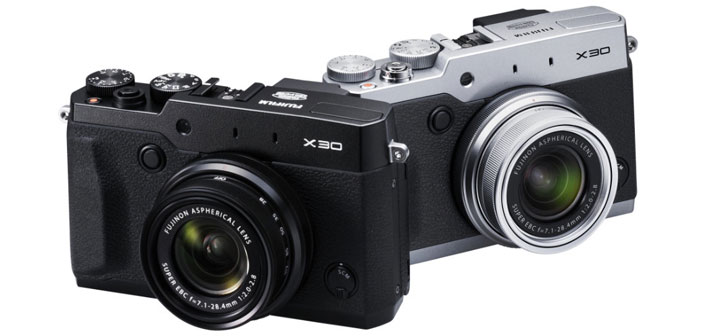” Fujifilm today announces its new Fujifilm X30, the latest evolution of the compact top of the range based on X-Trans sensor with 12 megapixels in size 2-3. ” Optics and electronics almost unchanged interface revisited with abandonment of the optical viewfinder in favor of an EVF.
Fujifilm today announces X30, the third generation of its compact top of the range based on the much X-Trans CMOS sensor II by 2.3 “, which does not require the optical low-pass filter to control moire and false colors.
The megapixel count is not increased compared to the previous X20 (12 Mp), as well as have not changed the specifications of the optics, which remains one 4x manual zoom equivalent to 28mm-112mm f / 2.0-2.8 consists of 11 elements in 9 groups with three aspherical elements and two ED elements, and 7-blade diaphragm. Though the focus is not very long, the lens is stabilized and credited to 3 stop advantage in shooting freehand.
Unchanged even the hybrid AF system, which according to Fujifilm X30 can focus in only 0.06 sec working in phase detection mode, and the identical shooting interval, equal to 12 fps, even if the duration of the burst was increased to 18 consecutive shots in JPEG format. What has changed compared to the X20, then? The interface, starting from the viewfinder.
The advanced optical viewfinder hybrid ” Advanced Optical Viewfinder “, able to show the main shooting information superimposed on the subject, which had also been a source of pride for the previous model, it has been abandoned here in favor of the new Electronic Viewfinder ” Viewfinder Real Time ” .
According to Fuji, it is the larger viewfinder and fastest in its class. Provides, in effect, a generous magnification of 0.65x (35mm equivalent), which is essentially the same as that found on entry-level SLR APS-C and according to the manufacturer display delay is contained in only 0.005 sec.
The screen of Fujifilm X30, an OLED 2.36 million points, offers automatic brightness control in relation to the ambient light level and allows a double vision with / without preview on the shooting conditions, for a realistic view of the final effect or a vision more similar to that of the optical viewfinder. The new viewfinder also recognizes the portrait orientation.
Surely someone will regret the disappearance of the optical viewfinder, but in all honesty, on models so compact optical viewfinder is often too narrow to be comfortable; on X20, specifically, covering only 85% field of view and the view was largely blocked at wide-angle optics …
Also changed the rear display, which is now slightly wider (3 inches), benefits from a double resolution (920,000 dots) and is tilting.
Still on the interface, it appeared on a new Fujifilm X30 control dial concentric lens, located behind the manual zoom ring that acts as a secondary allowing instant adjustment of aperture and shutter speed as well as, if desired, other parameters such as ISO, film simulation, white balance and continuous shooting.
About simulation film, debuts on the new Fujifilm X30 mode Classic Chrome devoted to reportage, characterized by soft gradations, richness of detail in the shadows and tones full, without saturation of the primary colors RGB.
The Fujifilm X30 was also inserted an eleventh film simulation mode called Classic Chrome, which adds to the line that includes Velvia for shooting landscapes with color images and Astia for a smoother, more natural tonal gradation of the skin in portraits. ” Classic Chrome ” has been developed to enable you to get the tonal depth required by documentary photography and reportage of the street.
To simulate the depth of the colors, your slides printed on paper Matte Deep, Fujifilm has developed a new algorithm capable of incorporating soft gradations, rich detail in shadows and full tones, avoiding the saturation of the blue, green and red. Among the changes also signal the macro to 1cm and the presence of the focus peaking to assist the manual focus.
Another new feature of the Fujifilm X30 is the integration of Wi-Fi module with remote shooting from smartphones and tablets. Finally, and this is certainly a welcome improvement. Autonomy was increased by a factor of 1.8x compared to the X20 and now reaches 470 shots.



